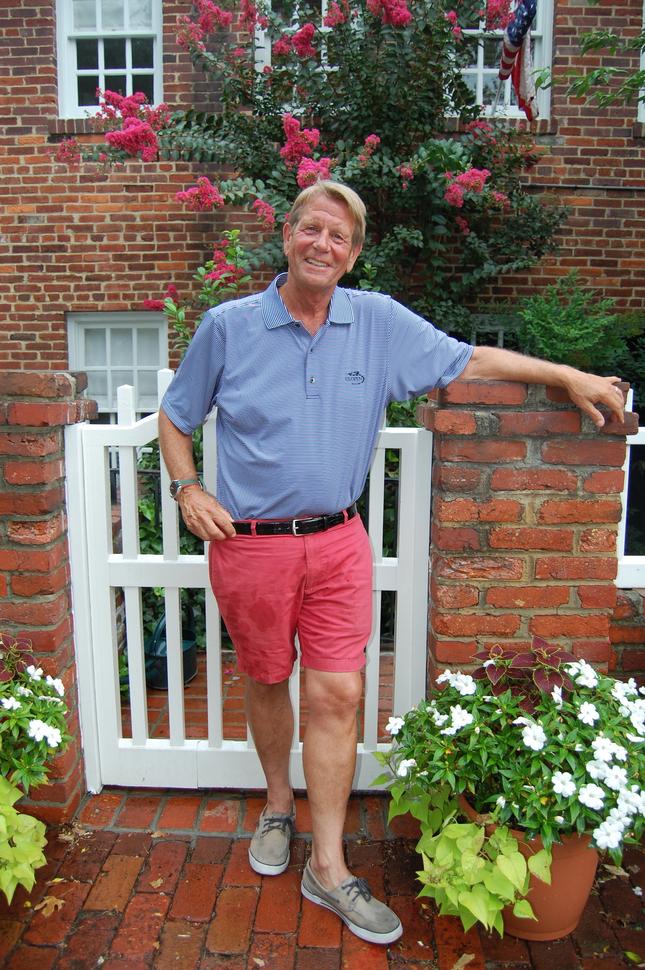A Walk in the Park … Rose Park, That Is, With David Dunning
By • August 10, 2016 0 2842

Unless you are vacationing in Paris, there is no place more beautiful than Georgetown on a Saturday morning. The fair weather and bright flowers colored my path as I set off for my next interview.
“Are you David?” I asked a gentleman standing on the steps of Mount Zion United Methodist Church, where Dunning is a board member. We were scheduled to talk about Rose Park, located down O Street from the church. A Georgetown resident since 1974, Dunning has served for 12 years on the 15-member board of the Friends of Rose Park — since 2008 as its president.
“You must be Shelia,” he said, greeting me as if he were the mayor of Georgetown. In many ways, he is, as I discovered while we walked toward the park. He shared his connection to Mount Zion and talked about how important all the churches in Georgetown are to him and to the neighborhood’s other residents.
I realized that Dunning is a walking history book. His love for Georgetown and for preserving its history are as contagious as his warm spirit. Every few steps, he would wave at a neighbor as he continued to explain Georgetown’s history to me — brick by brick, tree by tree.
A partner at a D.C. law firm, Dunning said that one of his top causes is to preserve the history of the park and of the people who once played and walked in this space. He and his wife Margaret and their neighbors understand Rose Park and its legacy. It is important to him that all history be passed down for generations to come — including the history of African Americans, who have been shortchanged by history books. Some books, such as “Georgetown Remembered,” published 25 years ago, tell such overlooked stories, including that of Rose Park.
Like other places in Georgetown, Rose Park was originally for African Americans. The first official records show a donation from the Ancient Order of the Sons and Daughters of Moses for the plot of land, with instructions for the park to be used by the black children who lived in the area. At one point, the park was called Patterson Park, and then Jacobs Park. No matter the name, Rose Park was the only place people of color could take their children to play during the days of segregation. Black children were not allowed to visit parks with white children — nor could they go to school with them or eat in the same restaurant.
By 1930, the hearts and minds of some of the people in Georgetown had changed; blacks and whites began to play in and enjoy Rose Park together. Little did they know that the Jim Crow laws that plagued the South were also in Washington. The D.C. Parks and Recreation Department attempted to segregate the playground with “For Colored Only” signs.
Maybe the laws had not changed, but people in Georgetown — black and white — had. They protested the new signs and forced the city to remove them. Years later, the city put it on record that Rose Park was one of the first integrated parks in the District of Columbia.
While the “Colored Only” and “Whites Only” signs are long gone, there are many reminders of African Americans’ rich history in Washington’s oldest neighborhood.
One reminder is now etched in metal, just as Dunning and other members of the Friends of Rose Park hoped. Dunning smiled as he pointed out the monument to honor the tennis greats Margaret and Roumania Peters, and recalled the day the tennis courts were named for them.
“October 24, 2015, was a proud moment for me, when we renamed the Margaret Peters and Roumania Peters Walker Rose Park Tennis Courts,” Dunning said, as I read the marker and thought about the sisters who grew up nearby at 2710 O St. NW.
The Peters sisters learned to play tennis at Rose Park and went on to become world champions. Celebrities like Gene Kelly came to Rose Park just to play the famous sisters.
With the help of Mayor Muriel Bowser and Secretary of Homeland Security Jeh Johnson, Dunning and others pulled the veil off the monument. Roumania Walker’s children Fannie Weekes and James Walker spoke fondly of their mother and aunt, whose record for winning 14 doubles championships has yet to be broken. It was fitting that Johnson, who lives across from the courts, gave the keynote address, expressing pride for his neighbors and the progress they have made together.
Today, the Friends of Rose Park continue their daily duties. These involve a lot of work, such as maintaining the park’s landscaping and looking after the tennis courts, basketball court, flag pole and tot lot, as well as the farmers’ market every Wednesday afternoon and the occasional outdoor movie in the summer. Recently, the group had to remind neighbors of D.C.’s leash laws, as dogs — who love Rose Park, too — were running loose a little too much.
Dunning and the Friends of Rose Park remain loyal to the people and to the park, which they hope will last for generations to come. With that in mind, the group’s big fundraiser, celebrating the group’s 20th anniversary, will be at Evermay on Oct. 6.
Like the park, the people have survived the worst of times, when others tried to separate them by the color of their skin.
When I finished my walking tour, I had so many things on my heart about Rose Park. Nothing stood out as much as the black and white people who said, “Take down your ‘For Colored Only’ signs.” If only the whole world were that way … well … I guess life would be like a walk in the park.

